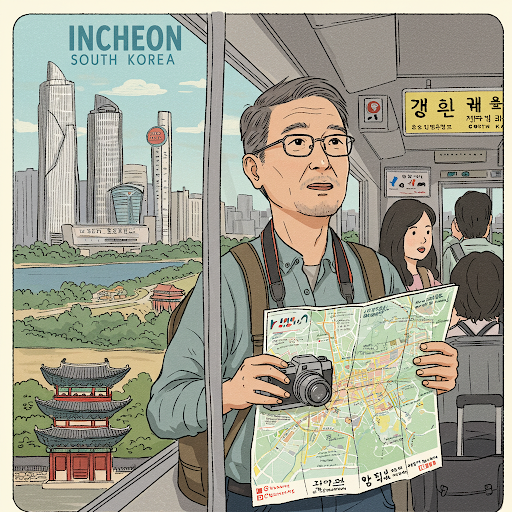Busan Airport to Downtown Transportation Guide: A Practical Guide for Foreign Tourists
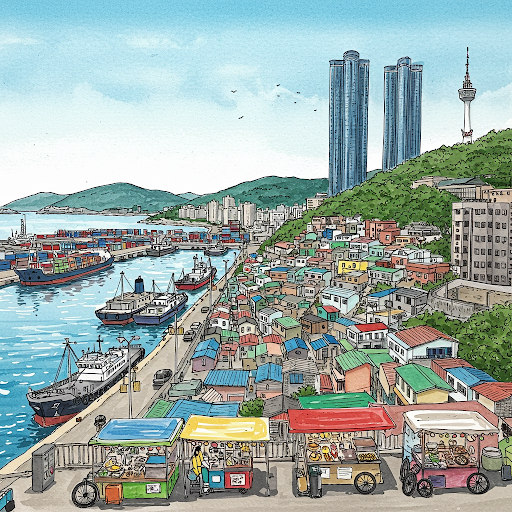
Gimhae International Airport (PUS) in Busan is South Korea's second busiest airport, connecting numerous cities worldwide. For first-time foreign visitors, figuring out how to efficiently and affordably get from the airport to downtown areas like Seomyeon, Haeundae, or Busan Station can be a crucial concern. This guide provides a detailed breakdown of five main transportation options, covering travel times, costs, pros and cons, and practical tips to help you kick off your Busan adventure with ease!
Airport Overview and Transportation Options at a Glance
Gimhae International Airport is located about 12–15 kilometers from downtown Busan. Depending on your destination, travel times range from 40 minutes to 90 minutes. Below is a quick comparison of the main transportation options:
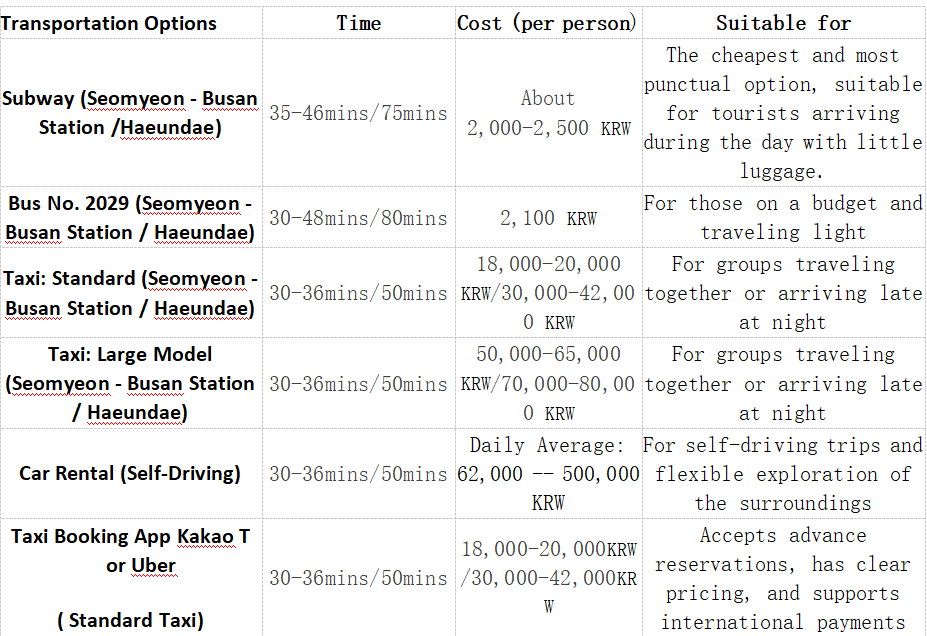
Subway: The Most Economical Travel Option
Route and Steps
1.Take the Busan-Gimhae Light Rail from the airport to Sasang Station.
From the airport's basement level (B1), board the Busan-Gimhae Light Rail and head to Sasang Station (사상역, Sasang Station). The journey takes about 15 minutes, including walking and travel time.

2. Transfer at Sasang Station to Busan Subway Line 2
- To reach Seomyeon Station, transfer to the Green Line 2 at Sasang Station, which goes directly to Seomyeon Station (about 20 minutes of walking and transfer time).
- To reach Busan Station, transfer to the Green Line 2 at Sasang Station, then transfer to the Red Line 1 at Seomyeon Station (about 31 minutes of walking and transfers).
- To reach Haeundae, take the Green Line 2 at Sasang Station, which goes directly to Haeundae Station (about 60 minutes of walking and transfers).
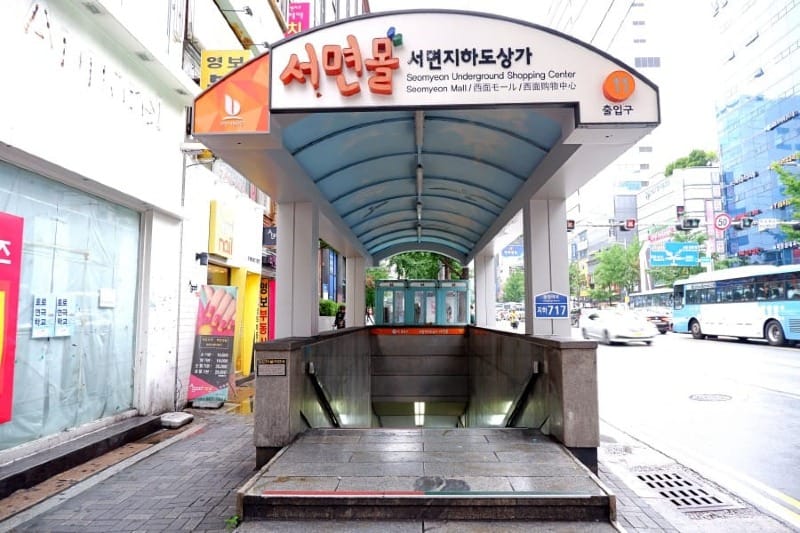

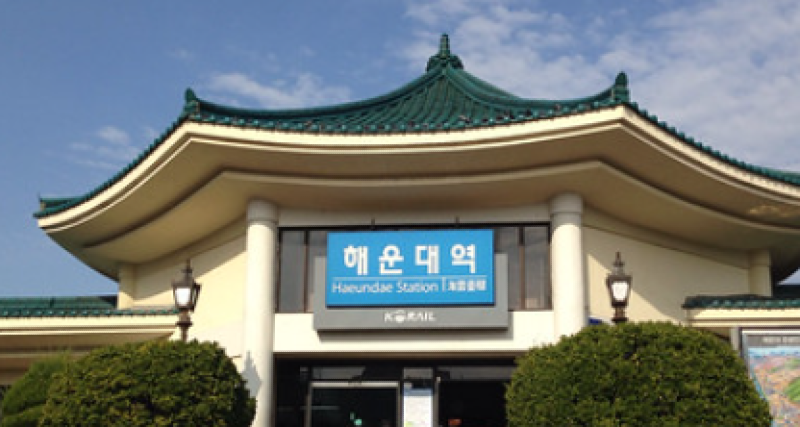
Cost and Ticket Purchase
One-Way Fare: Starting from 1,500 KRW + subway fare based on distance (total around 2,000-2,500 KRW to downtown).
Recommended Use of a Transportation Card:
You can purchase a T-money card at airport convenience stores (CU/GS25) for 3,000 KRW (for the card itself). After recharging, you can enjoy transfer discounts (free transfers to other subways or buses within 30 minutes in the city, up to a limit of four transfers).
Alternatively, you can purchase a single-use transportation card from the ticket machines.

Pros and Cons
Pros: The cheapest option with high punctuality, suitable for tourists arriving during the day with little luggage.
Cons: Transfers require walking, the last train departs around 23:00, so alternative transportation is needed for late-night arrivals.
Bus No. 2029: A Convenient Direct Option to the City Center
Main Route and Boarding Points
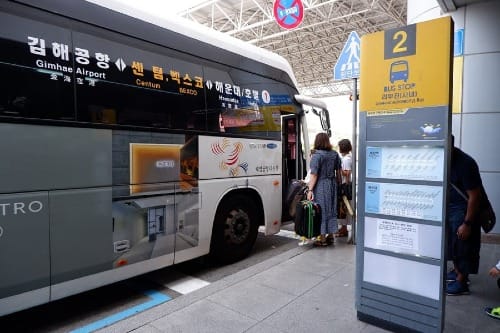
Boarding Point: Bus No. 2029 departs from the 1st floor (Arrival level) outside the airport at the designated 2029 bus stop.
Popular Routes:
- Seomyeon Station: Direct route to Seomyeon Station, approximately 30 minutes.
- Busan Station: First, reach Seomyeon Station, then transfer to Bus No. 81 to Busan Station, approximately 48 minutes.
- Haeundae Station: Direct route to Haeundae Station, approximately 80 minutes.
Ticketing and Schedule:
- Ticket Price: One-way fare is 2,100 KRW, payable by T-money card.
- Frequency: About once every 60 minutes, operating from 06:00 to 22:00.
Pros and Cons:
Pros: Direct service to popular areas, affordable fare.
Cons: Possible traffic congestion during peak hours, luggage limit of 20kg, size restriction of 50×40×20 cm.
Taxi: A Comfortable Point-to-Point Direct Option
Type and Fare
Standard Taxi (Silver/White):
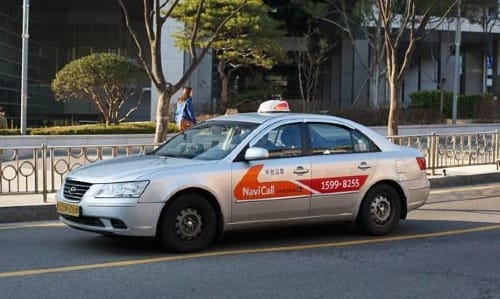
Starting Fare: 4,800 KRW (for the first 2 km)
- To Seomyeon / Busan Station: Approximately 18,000–22,000 KRW, taking about 30–36 minutes.
- To Haeundae: Approximately 30,000–42,000 KRW, taking about 50 minutes.
- Late-Night Surcharge: Additional charges apply during late-night hours.
Large Taxi (Black Model Taxi):
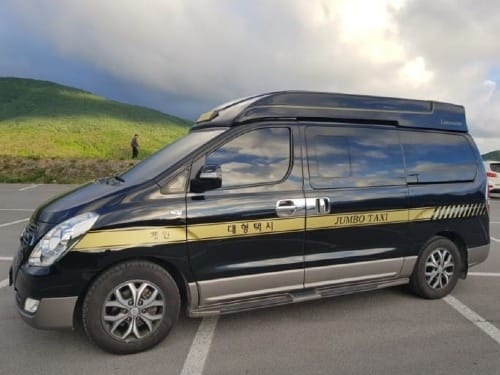
Starting Fare: 7,500 KRW, ideal for 5 or more people or situations with a lot of luggage.
- To Seomyeon / Busan Station: Approximately 50,000–65,000 KRW.
- To Haeundae: Approximately 70,000–80,000 KRW (prices are for reference and may vary based on actual conditions).
- Late-Night Surcharge: Additional charges apply during late-night hours.
Hailing a Taxi and Payment:
- Boarding Point: Designated taxi area on the 1st floor of the airport (queue according to signs).
- Payment Methods: Cash or credit card (some drivers may refuse foreign credit cards, so it's recommended to have cash).
- Language Issues: It's helpful to write your destination address in Korean in advance (or show a map location) as drivers may have limited English proficiency.
Pros and Cons:
Pros: 24-hour service, ideal for late-night arrivals or groups traveling together.
Cons: Higher fare, with potential surcharges during traffic congestion.
Car Rental (Self-Driving): Explore Busan and Its Surroundings Freely
Car Rental Process and Important Considerations
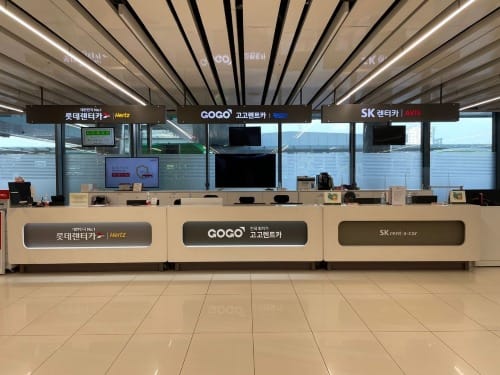
Car Rental Companies:
At the airport, you can find rental counters for companies like Hertz, AVIS, LOTTE Rent-a-Car, located on the 1st floor Arrival Hall.
Required Documents:
- International Driving Permit (IDP)
- Original Driver’s License from your home country
- Passport
- Credit Card (for security deposit authorization)
Costs:
- Daily Average: 62,000 to 500,000 KRW (Some rentals include insurance).
- Smaller cars tend to be more affordable.
- Travel Time: Similar to taking a taxi.
Pros and Cons:
Pros:
- Ideal for road trips and greater travel freedom.
- Offers a more flexible and enhanced travel experience.
Cons:
- Higher costs, including rental and insurance.
- You will need to manage parking on your own.
Navigation and Driving Tips:
Navigation Apps:
- KakaoMap or Naver Map (both support English input).
Important Notes:
- Driving: In Korea, driving is on the right-hand side of the road, and strict speed limits must be followed.
- Parking Fees: Parking in the city is relatively expensive (around 2,000 KRW per hour, with a daily maximum of 8,000 KRW). It’s advisable to book hotels that offer parking.
Ride-hailing App (Kakao T/ Uber): Simple and Convenient Choice
KakaoT
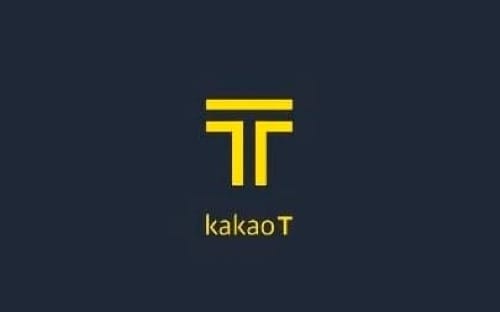
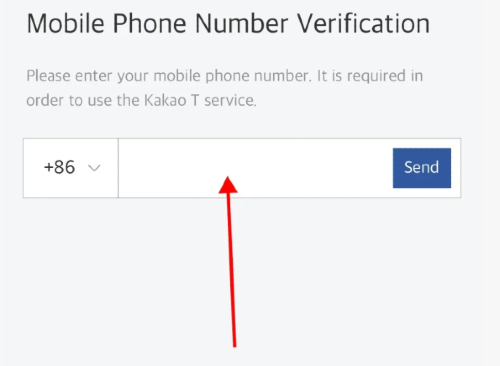
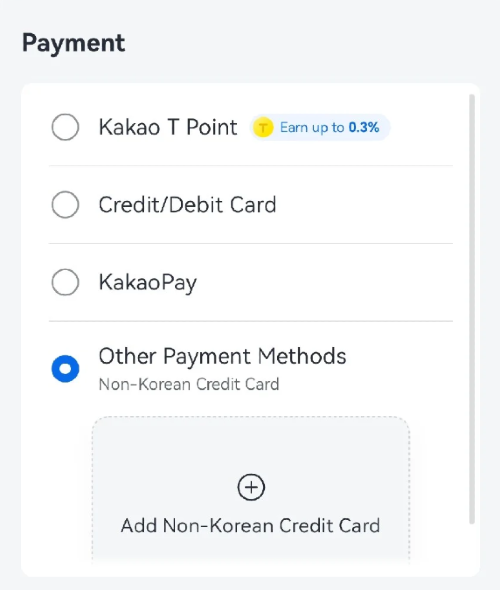
Usage Steps
Download the App: Download "Kakao T" from your app store in advance.
Registration and Binding: You can register with both Korean and international phone numbers, and it supports binding international credit cards.
Types of Rides:
- Standard Taxi: Same price as regular street hailing. (Reduces the likelihood of drivers intentionally taking longer routes, making it more trustworthy and safe.)
- Model Taxi: Higher-end vehicles with better service, though the fare is higher.
Pros and Cons:
Pros:
- Vehicle booking can be done in advance.
- Some drivers can communicate in simple English.
Cons:
- A pre-authorized fare is charged when you get in the taxi, and the remaining amount is refunded after payment.
- Refunds for international cards can take anywhere from 3 to 15 days, while refunds for Korean cards are typically processed faster.
Uber

Target Audience: All tourists.
Key Features:
- Supports instant taxi hailing, reservations, and more.
- Supports registration with both Korean and international phone numbers, and linking international credit cards (Visa/Mastercard).
- Supports multiple languages, including Chinese and English.
- More international-friendly compared to Kakao T.
Real-name verification: Overseas phone numbers can be registered, but payments can be linked to both Korean and international bank cards.
Important Notes:
- Only some drivers support foreign language communication, and communication may sometimes require translation software.
Practical Tips
1.Currency and Payment:
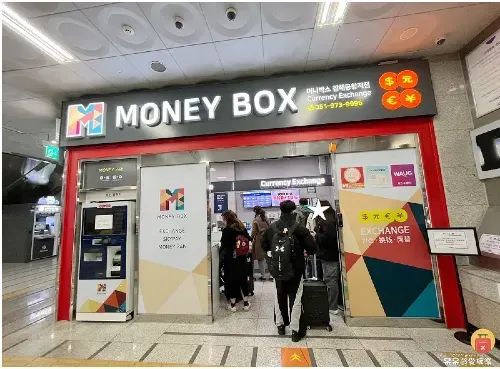
Currency Exchange and ATMs on the 1st Floor
- Wi-Fi and SIM card:
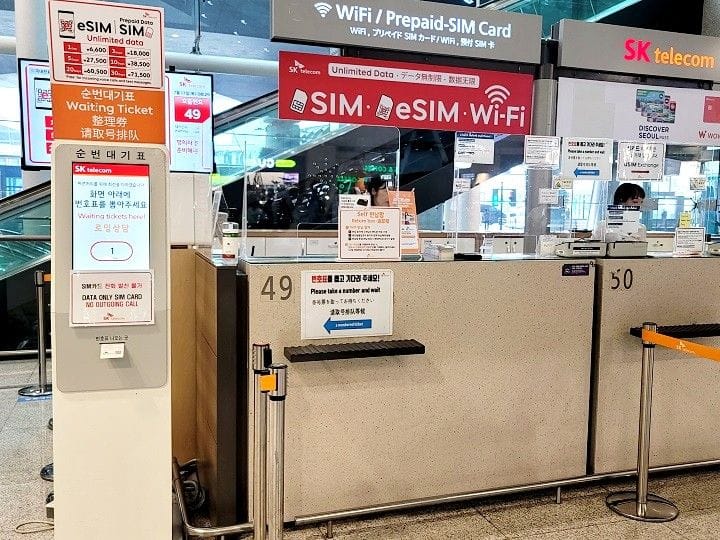
Wi-Fi Machine Rental or Prepaid SIM Card Purchase at the Airport
- Night Arrival Recommendations
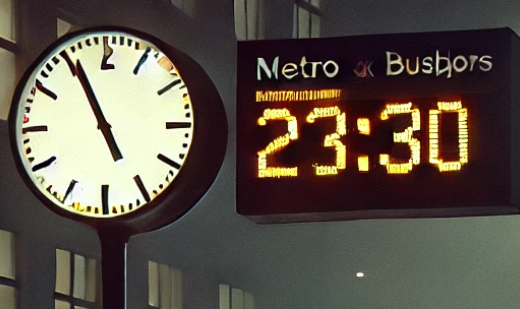
Arriving After 23:00 - Taxi And Subway Preferred
- Luggage Storage
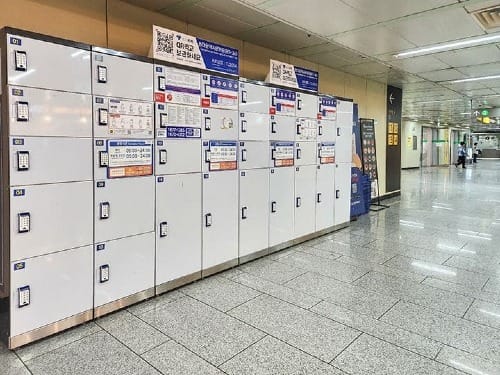
Self-Service Luggage Storage Lockers on the 1st Floor of the Airport
- Small luggage: Approximately 3,000 KRW for 4 hours
- Large luggage: Approximately 5,500 KRW for 4 hours
Conclusion: How to Choose the Best Option for You?
- Solo Travelers/Backpackers: Choose the subway during the day for the most economical option. At night, opt for the airport bus (2029 Express Bus) or use Kakao T for a self-hailing taxi.
- Families/Group Travelers: Taking a taxi is more cost-effective when shared (about 4,500-11,000 KRW per person for 4 people).
- Direct to Haeundae: The 2029 Express Bus is the most convenient option.
- Car Enthusiasts: Renting a car with an International Driving Permit allows for easy exploration of Busan and nearby areas (such as Gyeongju and Geoje Island).
Regardless of your choice, planning your route in advance, having the Korean address and cash ready will make your Busan trip smoother. Enjoy your journey!

